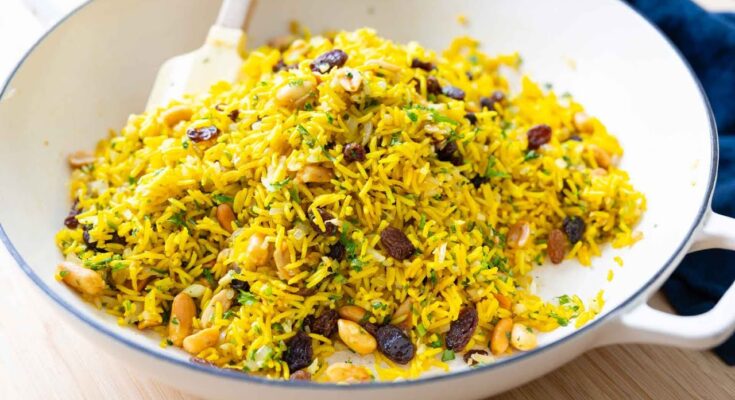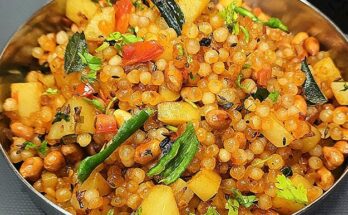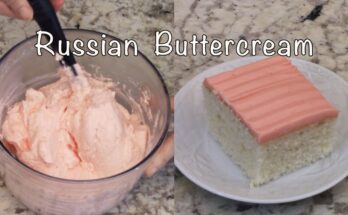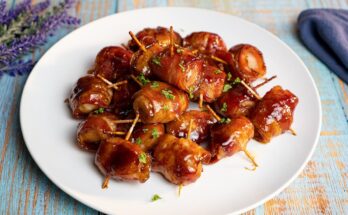Yellow Rice Recipe: Yellow rice is a vibrant and flavorful dish enjoyed across various cuisines worldwide. Known for its eye-catching golden hue, this dish combines fragrant spices, including turmeric, saffron, and cumin, to create a rich and savory experience. Whether you’re preparing a quick weekday dinner or hosting a festive gathering, yellow rice can be the perfect side dish to elevate your meal.
In this guide, we’ll walk you through a simple, step-by-step process to create the perfect yellow rice at home.
What is Yellow Rice?
Yellow rice is a rice dish that gets its vibrant color from spices like turmeric or saffron. It is commonly served as a side dish in Spanish, Indian, Middle Eastern, and South African cuisines. The bright yellow color symbolizes warmth, happiness, and festivity, making it a favorite for celebrations.
This rice is often flavored with garlic, onions, and broth, which enhance its taste. It’s a versatile recipe that can be customized with vegetables, nuts, or proteins, depending on preferences.
Benefits of Yellow Rice
Yellow rice isn’t just about flavor and appearance; it’s also packed with health benefits:
- Rich in Antioxidants: Turmeric contains curcumin, a powerful antioxidant that fights inflammation.
- Digestive Support: Spices like cumin and garlic promote healthy digestion.
- Gluten-Free: Naturally gluten-free, it’s a great option for people with gluten sensitivities.
- Versatile Nutrition: You can add vegetables or lean proteins for a balanced meal.
- Mood Enhancer: The bright color can uplift moods, and turmeric is known to improve brain health.
Ingredients for Yellow Rice Recipe
Main Ingredients
- 1 cup basmati or long-grain rice – Rinsed and drained
- 2 cups chicken or vegetable broth – Adds flavor
- 1 tablespoon olive oil or butter – For richness
- 1 small onion, finely chopped – Provides sweetness
- 2 cloves garlic, minced – Adds aroma
- 1 teaspoon turmeric powder – Gives the yellow color
- 1/2 teaspoon cumin powder – Adds depth of flavor
- 1/4 teaspoon paprika (optional) – For slight heat
- Salt and pepper to taste
Optional Add-Ons
- Vegetables: Peas, carrots, or bell peppers for added texture.
- Protein: Chicken, shrimp, or tofu for a complete meal.
- Nuts and Dried Fruits: Almonds or raisins for sweetness.
- Fresh Herbs: Cilantro or parsley for garnish.
Kitchen Tools Needed
- Medium-sized pot with a lid
- Measuring cups and spoons
- Knife and cutting board
- Wooden spoon or spatula
- Fork for fluffing rice
Step 1: Preparing the Ingredients
- Rinse the Rice: Start by rinsing the rice under cold water until the water runs clear. This removes excess starch and prevents the rice from becoming sticky.
- Chop Vegetables: Finely dice the onions and garlic to ensure even cooking.
- Measure Spices: Pre-measure all spices to make the cooking process smooth.
- Prepare Broth: Warm the chicken or vegetable broth in a separate pan or microwave for quicker absorption during cooking.
Taking time to prep properly makes the cooking process seamless and stress-free.
Step 2: Cooking the Aromatics
- Heat the Oil: In a medium pot, heat olive oil or butter over medium heat.
- Sauté Onions and Garlic: Add chopped onions and garlic, stirring frequently until softened and translucent (about 2–3 minutes).
- Toast the Spices: Stir in turmeric, cumin, and paprika. Let them cook for 30 seconds to release their aromatic flavors.
This step is crucial as it enhances the fragrance and richness of the dish.
Step 3: Adding Rice and Spices
- Mix in the Rice: Add the rinsed rice to the pot, stirring to coat it with the spices and oil. Toast for 1–2 minutes for a nutty flavor.
- Season: Add salt and pepper to taste. Adjust spice levels if necessary.
- Pour in Broth: Slowly add the warm broth, ensuring the rice is evenly covered.
This step locks in the flavor while allowing the rice to absorb the color and taste of the spices.
Step 4: Simmering to Perfection
- Bring to a Boil: Increase the heat to high and bring the mixture to a boil.
- Cover and Simmer: Once boiling, reduce the heat to low, cover with a lid, and let it simmer for 15–20 minutes.
- Check Doneness: After 15 minutes, check if the rice has absorbed the liquid. If it’s still slightly wet, cook for another 3–5 minutes.
Avoid stirring too often, as this can break the grains and make the rice mushy.
Step 5: Fluffing and Serving
- Rest the Rice: Once cooked, remove the pot from heat and let it sit, covered, for 5 minutes. This helps finish steaming the rice.
- Fluff with Fork: Use a fork to gently fluff the rice, separating the grains without mashing them.
- Garnish and Serve: Top with fresh herbs, nuts, or raisins for added texture and flavor.
Your golden, fragrant yellow rice is now ready to be served!
Pro Tips for the Best Yellow Rice
- Rinse the Rice Thoroughly: Always rinse the rice multiple times until the water runs clear. This step removes excess starch, ensuring the grains remain fluffy instead of clumpy.
- Use Warm Broth Instead of Water: Substituting water with broth (chicken or vegetable) adds layers of flavor and a richer taste.
- Sauté the Spices: Toasting the spices before adding liquid releases their oils, resulting in a deeper aroma and flavor.
- Don’t Rush the Simmering Process: Cooking on low heat allows the rice to absorb the flavors fully without burning or sticking.
- Rest Before Fluffing: Letting the rice rest for a few minutes after cooking prevents breaking the grains when fluffing.
Following these tips ensures consistently delicious and aromatic yellow rice every time!
Variations of Yellow Rice Recipe
Yellow rice is incredibly versatile and can be adapted to suit various cuisines. Here are a few ideas:
1. Spanish-Style Yellow Rice:
- Add saffron threads instead of turmeric for an authentic Spanish flavor.
- Include peas and roasted red peppers for a vibrant presentation.
- Pair it with seafood, such as shrimp or mussels, for a classic paella twist.
2. Indian-Style Yellow Rice:
- Add bay leaves, cinnamon sticks, and cardamom pods for a warm, spiced aroma.
- Toss in vegetables like carrots, peas, and potatoes for a wholesome meal.
- Top with fried onions and cashews for extra texture.
3. Caribbean-Style Yellow Rice:
- Use coconut milk instead of broth for a rich, creamy flavor.
- Add beans or pigeon peas for protein.
- Sprinkle chopped cilantro and lime juice for freshness.
4. Middle Eastern Yellow Rice:
- Incorporate dried fruits like raisins or apricots for sweetness.
- Use pine nuts or almonds as a crunchy garnish.
- Serve alongside grilled lamb or chicken kebabs.
No matter the variation, yellow rice remains a crowd-pleaser that pairs well with almost any cuisine.
Pairing Ideas – What Goes Well with Yellow Rice?
Yellow rice is incredibly versatile, making it a great side dish for many meals. Here are some delicious pairing ideas:
- Grilled Meats: Perfect with chicken, beef, or lamb kebabs.
- Seafood: Complements shrimp, grilled fish, or scallops beautifully.
- Vegetarian Options: Serve with roasted vegetables, stir-fried greens, or chickpea curry.
- Beans and Lentils: Ideal for protein-rich meals like black beans or lentil stews.
- Salads: Fresh cucumber and tomato salads with lemon dressing make a refreshing combination.
- Curries and Stews: Serve as a base for spicy curries or slow-cooked stews.
Pairing yellow rice with these dishes ensures a balanced and flavorful meal.
Storing and Reheating Yellow Rice
Storing:
- Allow the rice to cool completely before transferring it to an airtight container.
- Refrigerate for up to 4 days or freeze for up to 3 months.
Reheating:
- Microwave Method: Sprinkle a few drops of water over the rice, cover with a damp paper towel, and heat for 1–2 minutes.
- Stovetop Method: Add a splash of broth or water and stir over low heat until warmed through.
- Oven Method: Cover with foil and heat in an oven at 300°F (150°C) for about 15 minutes.
Proper storage and reheating techniques preserve flavor and texture.
Health Benefits of Turmeric in Yellow Rice
The key ingredient in yellow rice—turmeric—is celebrated for its health properties. Here are a few:
- Anti-Inflammatory Properties: Curcumin, the active compound in turmeric, reduces inflammation and pain.
- Boosts Immunity: Turmeric is rich in antioxidants, which help fight free radicals.
- Improves Digestion: It supports bile production, aiding in digestion.
- Heart Health: Turmeric may lower cholesterol levels and improve heart health.
- Brain Health: Studies suggest curcumin enhances memory and reduces the risk of neurological diseases.
By adding turmeric to yellow rice, you’re not just enhancing flavor but also boosting nutritional value.
Common Mistakes to Avoid
- Not Washing Rice Properly: Skipping this step can lead to sticky and clumpy rice.
- Using Too Much Water or Broth: Over-measuring liquid can result in mushy rice instead of fluffy grains.
- Skipping the Toasting Process: Failing to sauté spices before adding liquid reduces flavor depth.
- Cooking on High Heat: High heat may burn the rice or cook it unevenly. Always simmer on low heat.
- Stirring Too Often: Stirring breaks the grains and affects the texture—avoid this mistake.
- Not Letting Rice Rest: Resting is essential for fluffy rice; skipping it can make the dish dense.
Avoid these errors for a foolproof yellow rice dish every time.
FAQs about Yellow Rice Recipe
1. What gives yellow rice its distinct color?
Yellow rice gets its vibrant color primarily from turmeric, a spice well-known for its health benefits and earthy flavor. Some recipes also use saffron or annatto for color and a unique taste.
2. Is yellow rice gluten-free?
Yes, yellow rice can be gluten-free if made with ingredients that do not contain gluten. Always check the labels of any store-bought broth or seasonings to ensure they are gluten-free.
3. Can I make yellow rice in a rice cooker?
Absolutely! To make yellow rice in a rice cooker, simply add rice, water, turmeric or saffron, and any other desired spices to the cooker, and follow the standard cooking instructions for your model.
4. What are the best spices to add to yellow rice?
Alongside turmeric or saffron, common spices include cumin, coriander, and a bay leaf. Garlic and onion powders also enhance the flavor significantly.
5. How can I make yellow rice more flavorful?
Enhance yellow rice by sautéing onions and garlic in olive oil before adding the rice. You can also cook the rice in chicken or vegetable broth instead of water and add peas, carrots, or raisins for extra texture and sweetness.
6. Is yellow rice suitable for a vegan diet?
Yellow rice is vegan-friendly if cooked with vegetable broth and without any animal-derived ingredients. It’s a versatile side that complements many vegan dishes beautifully.
7. How long does yellow rice last in the fridge?
Properly stored in an airtight container, yellow rice can last up to five days in the refrigerator. Make sure it cools to room temperature before storing to maintain the best quality.
8. Can yellow rice be frozen?
Yes, you can freeze yellow rice for up to three months. Freeze it in airtight containers or heavy-duty freezer bags to preserve its taste and texture.
Conclusion
Yellow rice is a simple yet flavorful dish that can transform any meal into a celebration. With its vibrant color, aromatic spices, and versatile pairings, it’s no wonder this recipe is loved worldwide. Whether you’re preparing a quick dinner or hosting a party, this step-by-step guide ensures you create the perfect yellow rice every time.
Try experimenting with variations and toppings to make it uniquely yours. With the tips, storage instructions, and pairing ideas provided, you’ll have no trouble mastering this recipe. So, roll up your sleeves and get cooking—you won’t regret it!



